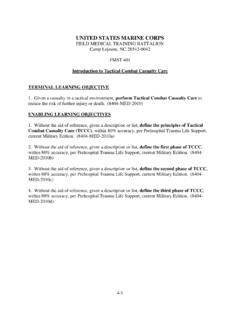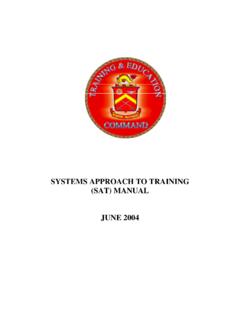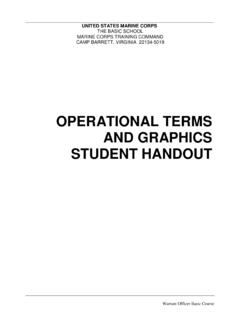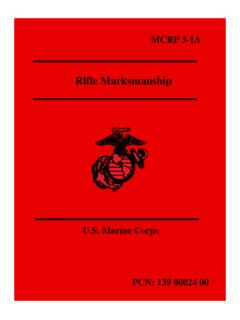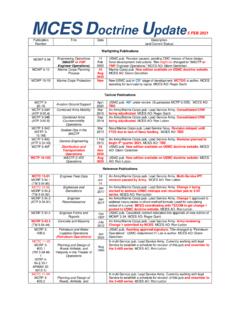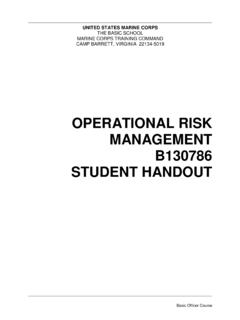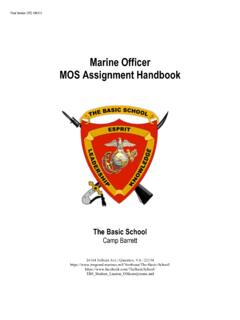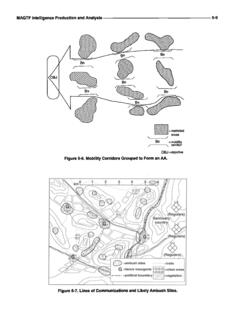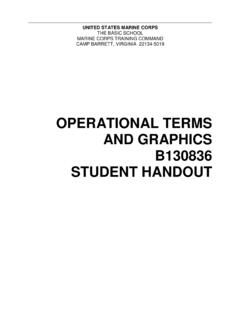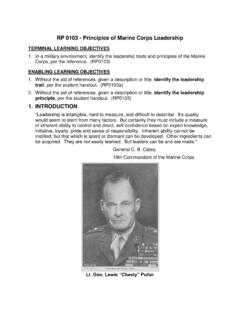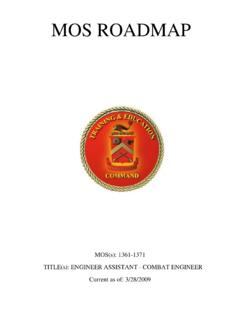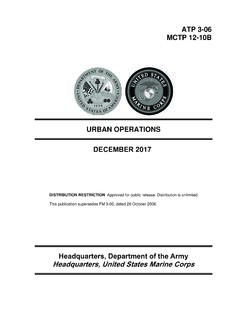Transcription of WARFIGHTING B130876 STUDENT HANDOUT
1 UNITED STATES MARINE corps THE BASIC SCHOOL MARINE corps TRAINING COMMAND CAMP BARRETT, VIRGINIA 22134-5019 WARFIGHTING B130876 STUDENT HANDOUT Basic Off icer Course B130876 WARFIGHTING 2 Basic Officer Course WARFIGHTING Introduction Marine corps Doctrinal Publication (MCDP) 1, WARFIGHTING , describes the Marine corps philoso phy on WARFIGHTING . It provides the authoritative basis for how the Marine corps fights and prepares to fight. MCDP 1 does not provide techniques or procedures. Rather, it sets forth general guidance that requires judgment in application. While authoritative, it is not prescriptive. Importance The co nce pts discuss ed in this lesson se rve as the foundation for all future tactical and leadersh ip training.
2 In This Lesson This less on covers the follo wing topics: Topic Page The Nature of War 3 The Theory of War 5 Preparing for War 10 The Conduct of War 12 Summary 14 References 14 Glossary of Terms and Acronyms 14 Notes 14 Learning Objectives Terminal Learning Objecti ves TBS-OFF-2102 Given a mission, implement Marine corps WARFIGHTING concepts to accomplish the mission. Enabling Learning Objecti ves TBS-OFF-2102e Without the aid of reference s, define war without error. TBS-OFF-2102f Without the aid of references, describe the nature of war without error. TBS-OFF-2102g Without the aid of reference s, describe the spectrum of conflict without error. TBS-OFF-2102h Without the aid of reference s, describe the levels of war without error.
3 TBS-OFF-2102j Without the aid of references, describe the maneuver warfare concepts without error. B130876 WARFIGHTING 3 Basic Officer Course The Nature of War War Defined Eve rything in war is simple, but the simplest thing is difficult. The difficulties accumulate and end by producing a kind of friction that is inconceivable unless one has experienced war. Carl von Clausewitz War is a violent clash of interests between or among organized groups characterized by the use of military force. Traditionally, these organized groups consist ed of regular armed forces from nation-states, but they may include non-state armed groups, such as se ctarian militias, insurgents, or terrorist organizations.
4 The ess ence of war is a violent struggle between two hostile, independent, and irreconcilable wills, each trying to impose its elf on the other. War is a co ntinuous interactive proce ss of mutual adaptation, move and countermove. The object in war is to impose our will on our enemy. The means to this end is the organized application or threat of violence by military force . Battl efield Dynamics War is both timeless and ever changing. The advancement of technology and evolution of tactics over time do not change the nature of war. The nature of war and battlefield dynamics remain constant through the changes. Leaders must understand the battlefield dynamics and how to mitigate their effects on su ccess.
5 Fear, uncertainty, chaos, and disorder are battlefield dynamics as natural as war itself. Colle cti vely referred to as frict ion, these dynamics are part of the very essence of war and what make s the simple difficult and the difficult seemingly impossible. Leaders must thrive on the friction-filled battlefield. Friction Friction makes the si mple difficult and the difficu lt se emingly impossible. The very essence of war creates friction. Friction may be described by four causa l fact ors. Mental Source s could be indecision by leaders and decision-make rs at various levels. Conflicting battlefield reports about the enemy, terrain, and friendly force s may lead to hesit ation in decision making.
6 Physical Source s include effective enemy fire or a terrain obstacl e that must be overco me. Being aware of and planning for these circumst ances allo ws leaders to exercise flexibility in an uncertain environment. External Factors imposed by enemy acti on, terrain, weather, and simple chance. Self-Induced (Internal) Caused by su ch factors as lack of a cl early defined goal, lack of co ordination, unclear or co mplicated plans, co mplex task organizations or command relationships, or complicated technologies. B130876 WARFIGHTING 4 Basic Officer Course The Nature of War (Continued) Uncertainty All acti ons in war take place in an atmosphere of uncertainty, the fog of war. Unknowns about the enemy, environment, and friendly sit uation co ntribute to the uncertainty on the battlefield.
7 Acti ons will be based on inco mplete, inaccurate, or contradictory information. Unce rtainty ca nnot be eliminated from the battlefield. Leaders must learn to fight effecti vely despite it. This can be done by developing simple, flexible plans; planning for likely contingencies; developing standing operating proce dures; and fost ering initiative. Fluidity Each acti on in war cannot be viewed in isolation. Each one is shaped by the action that preceded it and shapes the acti on that follo ws it. This creates a continuous, fluct uating flow of acti vity filled with fleeting opportuniti es and unforeseen events. Disorder War gravitates naturally toward disorder.
8 Plans will change. Orders will be unclear and misinterpreted. Communications will go down/fail. This natural disorder creates the conditions ready for exploitation by an opportunistic will. Leaders must not only be able to fight effectiv ely in the face of disorder, they should seek to generate disorder and use it as a weapon against our opponent. Complexity Each side in a conflict is not a single, homogeneous entity/unit guided by a single individual. Rather, each side is a co mplex sy stem consisting of numerous individual elements. Each element is part of a larger whole and must cooperate with other elements to acc omplish a co mmon goal. At the same time, each has its own mission and must adapt to its own sit uation.
9 The Human Dimension Because war is a clash between opposing human wills, the human dimension is central in war. It is the human dimension which infuses war with its intangible moral factors. War is shaped by human nature and is subject to the complexities, inco nsistencies, and peculiarities which characterize human behavior. Human will, instilled through leadersh ip, is the driving force of all acti on in war. Violence and Danger The means of war is force , applie d in the form of organized violence. Since war is a violent enterprise, danger is ever present. Fear, the human reaction to danger, contributes to the corrosion of will. Courage is the strength to overco me fear. B130876 WARFIGHTING 5 Basic Officer Course The Theory of War War as an Act of Policy The political object is the goal, war is the means of reaching it, and the means can never be considered in isolation from their purposes.
10 Carl von Clausewitz The theory of war provides the foundation for the way we prepare for and conduct war. The single most important thought to underst and about the theory is that war must se rve policy. Policy aims of war may vary from resistance against aggression to the unconditional surrender of an enemy government. The application of violence will vary in accordance with those aims. When the policy motive of war is extreme, such as the destructi on of an enemy government, there will tend to be few political restrictions on the military conduct of war. On the other hand, the more limited the policy motive, the more likely political considerations will restrict the applic ation of milit ary force.
